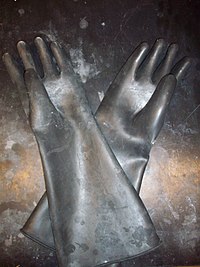Butyl rubber
Butyl rubber has excellent impermeability to gas diffusion, and the long polyisobutylene segments of its polymer chains give it good flex properties.
Polyisobutylene and butyl rubber are used in the manufacture of adhesives, agricultural chemicals, fiber optic compounds, ball bladders, O-rings, caulks and sealants, cling film, electrical fluids, lubricants (2 stroke engine oil), paper and pulp, personal care products, pigment concentrates, for rubber and polymer modification, for protecting and sealing certain equipment for use in areas where chemical weapons are present, as a gasoline/diesel fuel additive, and chewing gum.
Polyisobutylene (PIB) was first developed by the BASF unit of IG Farben in 1931 using a boron trifluoride catalyst at low temperatures and sold under the trade name Oppanol B [de].
It was later developed into butyl rubber in 1937, by researchers William J. Sparks and Robert M. Thomas, at Standard Oil of New Jersey's Linden, N.J., laboratory.
Today, the majority of the global supply of butyl rubber is produced by two companies, ExxonMobil (one of the descendants of Standard Oil) and Polymer Corporation, a Canadian federal crown corporation established in 1942 to produce artificial rubber to substitute for overseas supply cut off by World War II.
The company was privatized in 1988 with its sale to NOVA Corp which, in turn, sold Polysar Rubber in 1990 to Bayer AG of Germany.
In the spring of 2013 two incidents of PIB contamination in the English Channel, believed to be connected, were described as the worst UK marine pollution 'for decades'.
It is important[citation needed] to have the roof membrane fixed, as a lot of fixtures (e.g., air conditioner vents, plumbing, and other pipes) can considerably loosen it.
It is crucial to the integrity of such roofs to avoid using harsh abrasive materials and petroleum-based solvents for their maintenance.
Polyester fabric laminated to butyl rubber binder provides a single-sided waterproof tape that can be used on metal, PVC, and cement joints.
Butyl rubber is one of the most robust elastomers when subjected to chemical warfare agents and decontamination materials.
It is a harder and less porous material than other elastomers, such as natural rubber or silicone, but still has enough elasticity to form an airtight seal.

